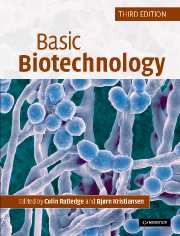Book contents
- Frontmatter
- Contents
- List of contributors
- Preface to the second edition
- Preface to the third edition
- Part I Fundamentals and principles
- Part II Practical applications
- Chapter 12 High-throughput screening and process optimisation
- Chapter 13 The business of biotechnology
- Chapter 14 Amino acids
- Chapter 15 Organic acids
- Chapter 16 Microbial polysaccharides and single cell oils
- Chapter 17 Environmental applications
- Chapter 18 Production of antibiotics by fermentation
- Chapter 19 Strategies of cultivation
- Chapter 20 Enzyme biotechnology
- Chapter 21 Recombinant proteins of high value
- Chapter 22 Insect and mammalian cell culture
- Chapter 23 Plant cell biotechnology
- Chapter 24 Biotransformations
- Chapter 25 Immunochemical applications
- Index
Chapter 14 - Amino acids
Published online by Cambridge University Press: 05 June 2012
- Frontmatter
- Contents
- List of contributors
- Preface to the second edition
- Preface to the third edition
- Part I Fundamentals and principles
- Part II Practical applications
- Chapter 12 High-throughput screening and process optimisation
- Chapter 13 The business of biotechnology
- Chapter 14 Amino acids
- Chapter 15 Organic acids
- Chapter 16 Microbial polysaccharides and single cell oils
- Chapter 17 Environmental applications
- Chapter 18 Production of antibiotics by fermentation
- Chapter 19 Strategies of cultivation
- Chapter 20 Enzyme biotechnology
- Chapter 21 Recombinant proteins of high value
- Chapter 22 Insect and mammalian cell culture
- Chapter 23 Plant cell biotechnology
- Chapter 24 Biotransformations
- Chapter 25 Immunochemical applications
- Index
Summary
Introduction
The story of amino acid production started in Japan in 1908 when the chemist, Dr K. Ikeda, was working on the flavouring components of kelp. The specific taste of the kelp preparations, kombu and katsuobushi, is traditionally very popular with the Japanese (Fig. 14.1). After acid hydrolysis and fractionation of kelp, Dr Ikeda discovered that one specific fraction he had isolated consisted of glutamic acid which, after neutralization with caustic soda, developed an entirely new delicious taste. This was the birth of the use of monosodium glutamate as a flavour-enhancing compound. The production of monosodium glutamate (MSG) was soon commercialised by the Ajinomoto Co. Ltd based on its isolation from vegetable proteins such as soy or wheat protein. However, with this process the waste fraction was high, and also the chemical synthesis of d,l-glutamate was of little use since the sodium salt of the d-isomer is tasteless.
The breakthrough in the production of MSG was the isolation of a specific bacterium by Dr S. Udaka and Dr S. Kinoshita at Kyowa Hakko Kogyo in 1957. They screened for amino-acid-excreting microorganisms and discovered that their isolate, No. 534, on a mineral salt medium excreted l-glutamate. It soon became apparent that the isolated organism needed biotin and that l-glutamate excretion was triggered by an insufficient biotin supply. A number of bacteria with similar properties were also isolated, which are today all known by the species name Corynebacterium glutamicum (Fig. 14.2). Corynebacterium glutamicum is a Gram-positive bacterium which can be isolated from soil.
- Type
- Chapter
- Information
- Basic Biotechnology , pp. 335 - 358Publisher: Cambridge University PressPrint publication year: 2006
- 4
- Cited by



